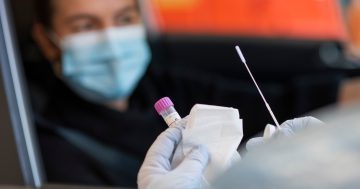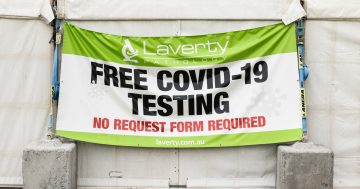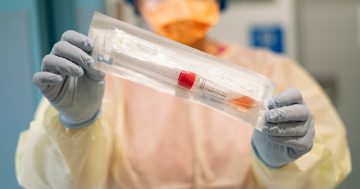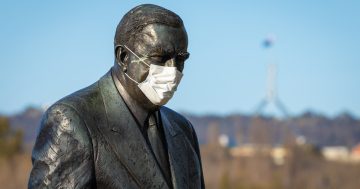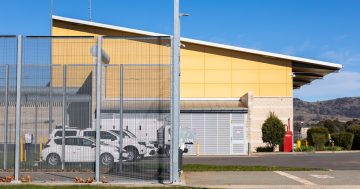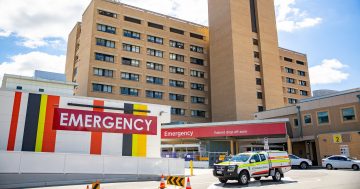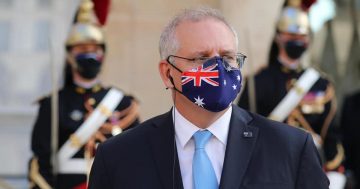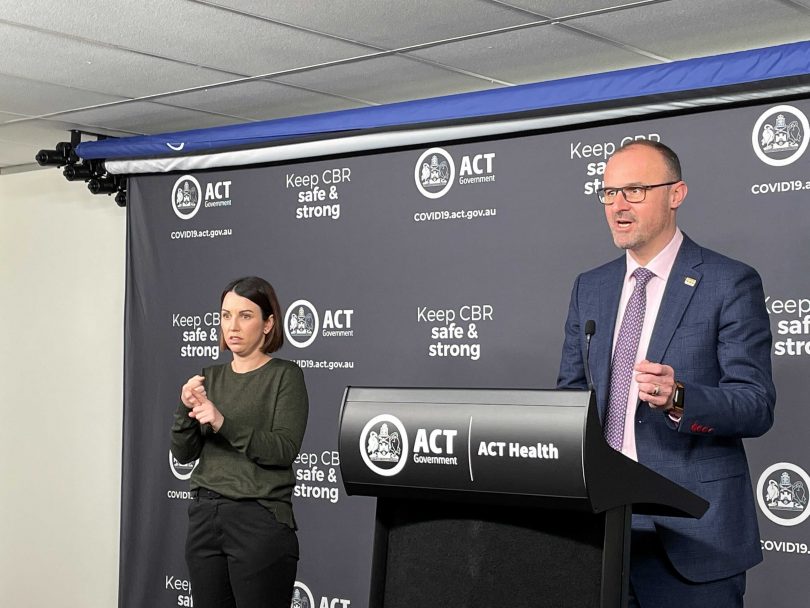
Chief Minister Andrew Barr speaking at this morning’s COVID-19 briefing. Photo: Dominic Giannini.
UPDATED 2:15 pm: Chief Minister Andrew Barr has sought to clarify changing travel restrictions and quarantine requirements between the ACT and NSW as both jurisdictions approach the 80 per cent fully vaccinated threshold and begin to open up.
Mr Barr said the Territory would seek a consistent approach with its neighbour enabling unrestricted regional travel for vaccinated residents when the 80 per cent threshold is passed towards the end of October.
“For the purposes of consistency, although we will confirm this, we would mirror NSW arrangements. The best advice I could give today because this has not been concluded yet is that if you are unvaccinated, your travel is going to be more limited,” Mr Barr said.
Mr Barr said he hoped this “reasonably free movement” between the ACT and the surrounding region would continue for unvaccinated residents despite the changes to NSW travel restrictions after the 80 per cent threshold is surpassed.
“My hope is that in the Canberra region … we will not have a vaccination check back and forth,” he said. “But if you wanted to go further than those postcodes, you would need to be vaccinated is my understanding of the NSW rules.
“That puts in place a set of interesting quandaries for us in terms of NSW residents outside of the defined Canberra region postcodes wanting to come into the ACT.
“Clearly, they would be travelling through part of NSW, so to meet the NSW requirements they would need to be vaccinated.”
ACT residents returning from hotspot areas, like Greater Sydney, need to undergo two weeks of quarantine.
A standing exemption is in place for postcodes within around a 100-kilometre radius. This includes Yass and Bungendore but does not extend as far as Goulburn or Braidwood. Residents of these postcodes do not need an exemption to enter the ACT from NSW.
Mr Barr said the quarantine requirement for vaccinated people entering the ACT may change in the coming weeks as the vaccination thresholds are reached and NSW eases restrictions for them.
“It would be logical to draw a distinction between vaccinated and unvaccinated people as to both the duration of quarantine and the location of quarantine, so a risk-based approach is likely to be applied,” he said.
“We have not yet concluded our thinking on those points but the principles will be around identified hotspots.
“What we might be dealing with in NSW is that some local government areas have got vaccination rates of 90 per cent or more and they will not be areas of concerns by the NSW Government.
“But it could be [that] certain local government areas where vaccination rates are lower could be in lockdown in October and November [barring them from entering the ACT].
“We do want to talk to NSW so if it is possible to have a consistent approach between the two jurisdictions, that would make life easier for everyone.”
12:30 pm: The ACT has recorded 22 new cases of COVID-19 in the past 24 hours – 12 are linked to current or identified close contacts and the remaining 10 are under early investigation.
Seven people were in quarantine for the entirety of their infectious period; at least seven spent part of their infectious period in the community.
Ten people are in hospital with COVID-19, three are in ICU and all require ventilation. None of those in intensive care are fully vaccinated. Yesterday, 3710 tests were carried out.
Today’s numbers come as the neighbouring Eurobodalla region recorded its first death in the current outbreak. A woman in her 70s from Batemans Bay, who was fully vaccinated, has died with COVID-19 at home. She was diagnosed with COVID-19 only after her death.
Deputy Chief Health Officer Dr Vanessa Johnston told today’s press briefing that the outbreak now totalled 804 cases, including 237 that are active. Of the 12 linked cases, 10 are household contacts.
There are now 14 cases linked to Calvary Hayden including 10 residents, three staff and one household contact. Dr Johnston said two more cases had been recorded overnight and would be included in tomorrow’s case numbers.
Since the outbreak began in August, daily cases have averaged 17.1. Over half of the cases are male with a median age of between 26 and 28 years. On average, 123 cases per week are now notified, and 32 cases remains the highest number in a single day.
“We are still seeing a larger number than we’d like of people delaying getting tested,” Dr Johnston said, noting that 40 per cent of people were now waiting two days after symptoms appear, while 10 per cent wait up to five days.
“This is far too high, especially as we are considering our pathway forward,” Dr Johnston said. “This is very concerning.”
The outbreak includes 88 cases where the source is unknown, over half during the past two weeks.
“These mystery cases suggest unidentified chains of transmission, and community transmission increases the risk to all of us, especially our most vulnerable groups,” Dr Johnston said.
Public health measures had significantly contributed to the ACT’s ability to ease out of restrictions, but COVID-safe measures remain a very important management tool.
Thirty two separate clusters have been identified with an average of 16 cases each and a range of between two and 52 cases. To date, there have been multiple separate introductions of the Delta variant into ACT, at least two resulting in significant community transmission.
Dr Johnston said that while daily numbers go up and down, the averages were staying steady and showed no evidence of exponential increase, giving the government confidence to begin easing restrictions.
Chief Minister Andrew Barr also urged people to come forward with the onset of any symptoms, or before that if in quarantine as a close contact.
“Every day you delay has a big impact not only on the people you possibly infect but also on how you as a patient can be treated especially if you are not vaccinated,” he said, noting that some treatments could only be administered in the first five days of infection.
“COVID is a terrible disease. I’ve not met anyone who had it who says they want it,” he said.
Earlier appointments for vaccination continue to become available and Mr Barr said people should check ACT Health websites and with their GPs or pharmacies for any available appointments so that as many people as possible will have at least their first shot by October 15.
Mr Barr said the Commonwealth announcements regarding tapering COVID disaster payments had been extensively reported and aligns with the ACT’s pathway forward. Additional weeks of payment will ensure October is covered.
11:50 am: The ACT has recorded 22 new cases of COVID-19 in the past 24 hours.
Of the new cases, 12 are linked to current or identified close contacts and the remainder are under early investigation.
Seven people were in quarantine for the entirety of their infectious period; at least seven spent part of their infectious period in the community.
Ten people are in hospital with COVID-19, three are in ICU and all require ventilation.
Yesterday, 3710 tests were conducted.
Today’s numbers come as the neighbouring Eurobodalla region recorded its first death in the current outbreak. A woman in her 70s from Batemans Bay, who was fully vaccinated, has died with COVID-19 at home, NSW Health said today. She was only diagnosed with COVID-19 after her death.
NSW recorded 863 cases and 15 deaths. Of those eligible in NSW, 86.2 per cent have now had one dose of the COVID-19 vaccine and 61.7 per cent are double-dosed.
Yesterday NSW had 863 new cases and seven deaths.
In Victoria, 950 cases were recorded and seven deaths.
Yesterday there were 867 new cases and four deaths.
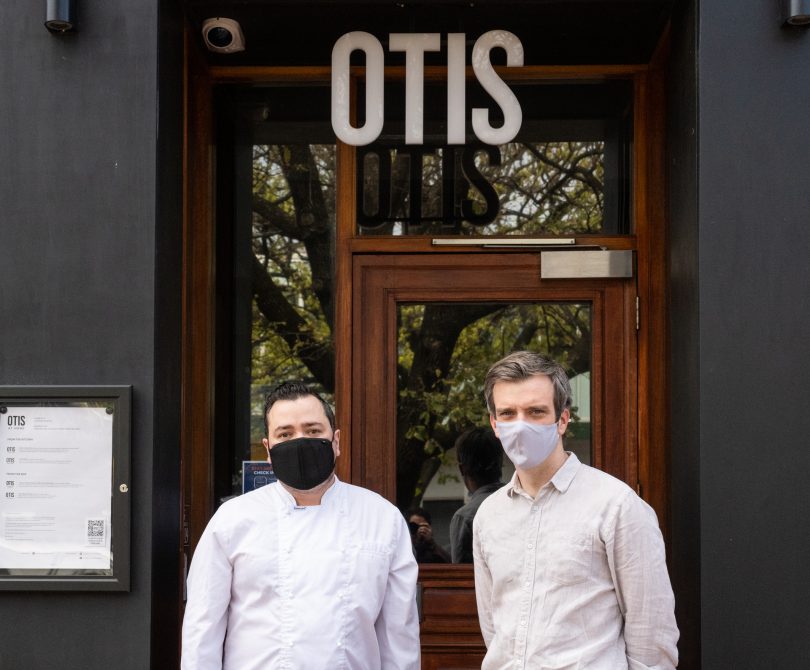
Owner and executive chef of OTIS in Kingston, Damien Brabender (left) and AHA ACT General Manager Anthony Brierley (right) are critical of the density limits for ACT businesses. Photo: Dominic Giannini.
10:10 am: The Commonwealth’s COVID-19 disaster payments are due to be scaled back and then stopped as states and territories hit key vaccination targets in a bid to avoid a continuation of restrictive in place lockdown conditions.
The payment provides up to $750 a week for people who have lost work due to lockdowns, and those on income support have seen an increase of $200 to their weekly payments.
This is expected to be wound back a fortnight after states or territories pass the 80 per cent vaccination rate and restrictions are eased in line with the national plan.
The initiative is causing concerns in the ACT, with owner and executive chef of OTIS in Kingston, Damien Brabender, saying it would take his businesses up to seven weeks to be able to start operating as they were before lockdown.
This would be made harder by a lack of income support for staff and a stoppage of any business support from the Commonwealth when the lockdown ends.
“A big issue leading into Christmas is going to be that outlay of businesses that have those annual leave payments,” he said.
“This is when a lot of our staff are taking their annual leave, about 80 per cent of annual leave in this industry is used over the second half of December and the beginning of January.”
Without additional support, casual staff would be the first to lose their hours, Mr Brabender said.
“If there was not business support from that Commonwealth level, we would be in dire straits. If we were to reopen and staff were not receiving that form of support, we simply would not have staff.”
This would be further impacted by density limits on ACT businesses once the lockdown ends on 15 October, he said.
“When you say to an employer – cut your revenue in half, cut the number of customers you are allowed to have in half but give everyone some hours, that is not possible.”
Restrictions in the ACT are due to ease further at the end of October as vaccination rates continue to rise, but density limits and a maximum number of patrons will still apply to venues.
Changes are “subject to the public health risk at the time” under the ACT’s pathway announced on Monday (27 September).
Exposure locations continue to grow in the ACT, with a number of supermarkets and takeaway stores across Belconnen, Phillip, Kambah, Weston, Fyshwick, Chapman and Wanniassa.
A full list of exposure sites can be found here.
Chief Minister Andrew Barr, Health Minister Rachel Stephen-Smith, and Deputy Chief Health Officer Dr Vanessa Johnston will provide an update on the ACT’s COVID-19 situation at 11:45 am.
More to come.












